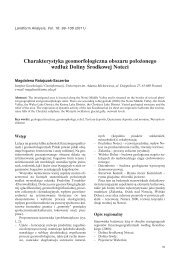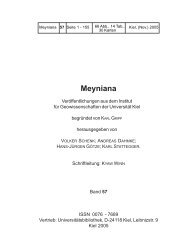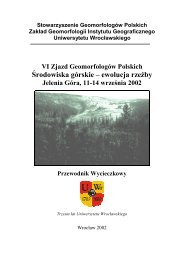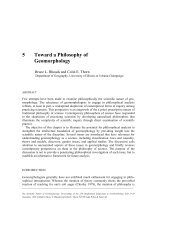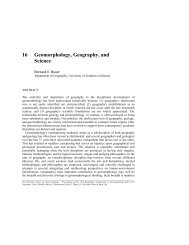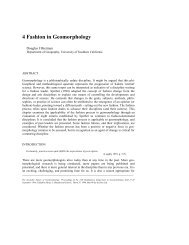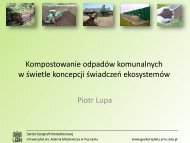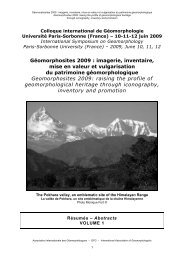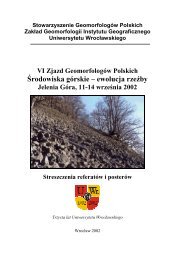Physical Modelling in Fluvial Geomorphology
Physical Modelling in Fluvial Geomorphology
Physical Modelling in Fluvial Geomorphology
Create successful ePaper yourself
Turn your PDF publications into a flip-book with our unique Google optimized e-Paper software.
232 SCIENTIFIC NATURE OF GEOMORPHOLOGY<br />
The supercritical to subcritical flow transition may also produce hydraulic jumps which<br />
have been observed to cause headward erosion <strong>in</strong> alluvial fan models (Parker 1996) and<br />
produce abrupt gravel to sand size sort<strong>in</strong>g <strong>in</strong> downstream f<strong>in</strong><strong>in</strong>g models (Paola et al.<br />
1992). Significant headward erosion of anabranches has also been observed with<strong>in</strong> braided<br />
river FSM studies (e.g. Ashmore 1982, p. 218), but it is unknown how common hydraulic<br />
jumps are <strong>in</strong> the field, particularly <strong>in</strong> braided channels with high width: depth ratios.<br />
Particle Settl<strong>in</strong>g<br />
The particle fall velocity <strong>in</strong> a stationary fluid can be considered us<strong>in</strong>g two different<br />
equations. Stokes' law considers only viscous resistance forces and is of the form<br />
Uf ∝ D 2 (15)<br />
where Uf is the fall velocity of a particle and D is the gra<strong>in</strong> size. For particles smaller than<br />
0.1 mm <strong>in</strong> water this relationship holds very well, but Stokes' law does not account for<br />
boundary layer separation beh<strong>in</strong>d a fall<strong>in</strong>g particle and a consequent <strong>in</strong>crease <strong>in</strong> the fluid<br />
drag. For large particles, Newton derived an expression, known as the impact law, that<br />
<strong>in</strong>corporates the effects of boundary layer separation<br />
Uf ∝ D 0.5 (16)<br />
The impact law is not a particularly good approximation of experimental results, even for<br />
particles larger than 1 mm (see Figure 9.5), and has many <strong>in</strong>adequacies when the particles<br />
are non-spherical. The comb<strong>in</strong>ed experimental curve does, however, break <strong>in</strong>to two<br />
dist<strong>in</strong>ct l<strong>in</strong>ear segments, one characterised by Stokes' law and the other broadly del<strong>in</strong>eated<br />
by the impact law. When both model and prototype gra<strong>in</strong> sizes fall exclusively with<strong>in</strong><br />
either of these two areas, a l<strong>in</strong>ear scal<strong>in</strong>g ratio can be applied. However, if the prototype<br />
gra<strong>in</strong> size is <strong>in</strong> the 'impact region' and the model is <strong>in</strong> the field of Stokes' law, then the<br />
function is nonl<strong>in</strong>ear and consequently cannot be perfectly scaled. The ma<strong>in</strong> result of this<br />
nonl<strong>in</strong>earity is that the fall velocities of the particles relative to the downstream velocity<br />
are much slower <strong>in</strong> the model than the prototype, although the particle time constant (the<br />
ratio of the particle response time to the characteristic eddy turnover time, see Elghobashi,<br />
1994) and relationship between particle size and turbulence <strong>in</strong> the model and prototype<br />
must also be taken <strong>in</strong>to account. Saltat<strong>in</strong>g particles <strong>in</strong> the model may consequently have<br />
larger hop lengths and heights than the geometric scale ratio would suggest. This<br />
limitation could be overcome by alter<strong>in</strong>g the gra<strong>in</strong>-size distribution as suggested by Jaeggi<br />
(1986) for <strong>in</strong>itiation of sediment movement, but this solution would also affect the mode<br />
of sediment transport.<br />
Bedload Transport and Deposition<br />
A scale ratio for sediment transport rate <strong>in</strong> models with fully turbulent flow, (λt)s can be<br />
derived by dimensional analysis (Yal<strong>in</strong> 1963, 1971),<br />
(λt)s = (λL) 1.5 (17)<br />
However, Yal<strong>in</strong> (1971) has demonstrated that if Re* is below the critical threshold for a<br />
fully turbulent boundary and the fluid and temperature are the same <strong>in</strong> the prototype and



